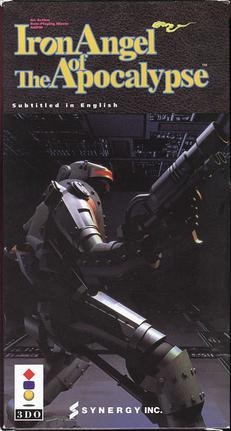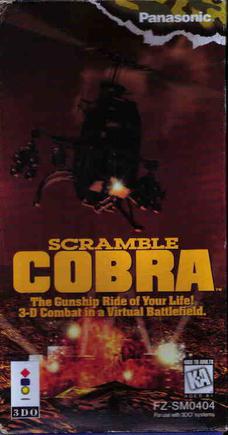
The 3DO Company, also known as 3DO, was an American video game company. It was founded in 1991 by Electronic Arts founder Trip Hawkins, in a partnership with seven other companies. After 3DO's flagship video game console, the 3DO Interactive Multiplayer, failed in the marketplace, the company exited the hardware business and became a third-party video game developer. It went bankrupt in 2003 due to poor sales of its games. Its headquarters were in Redwood City, California, in the San Francisco Bay Area.

The 3DO Interactive Multiplayer, also referred to as simply 3DO, is a home video game console developed by The 3DO Company. Conceived by entrepreneur and Electronic Arts founder Trip Hawkins, the 3DO was not a console manufactured by the company itself, but a set of specifications, originally designed by Dave Needle and RJ Mical of New Technologies Group, that could be licensed by third parties. Panasonic produced the first models in 1993, and further renditions of the hardware were released afterwards by GoldStar, Sanyo, Creative Labs, and Samsung Electronics in 1997.

Pinball Fantasies is a 1992 pinball video game originally developed by Digital Illusions and published by 21st Century Entertainment in Europe for the Amiga home computers. It is the sequel to Pinball Dreams, which was released earlier in the same year on multiple platforms. In the game, players can choose between any of the four available playfields, both of which have their own thematic and main objectives in order to obtain the highest score possible.

Road Rash 3D is a racing video game developed and published by Electronic Arts exclusively for the PlayStation.

Bill Budge is a retired American video game programmer and designer. He is best known for the Apple II games Raster Blaster (1981) and Pinball Construction Set (1983).

Galactic Pinball is a pinball video game for Nintendo's Virtual Boy game console. The game was released on July 21, 1995 in Japan and on August 14, 1995 in the United States. It is set in the Milky Way galaxy, and has players maneuvering a puck around one of four pinball tables available in the game. The Virtual Boy's standard red-and-black color scheme resulted in criticism of this and other games on the platform for causing nausea, headaches, and eye strain. It uses parallax, which allows the game to display three-dimensional effects. It has received a mixed reception; it was praised for its authenticity, while reception to its physics and controls were mixed. It has received criticism for its lack of ambition and originality.

Crash 'N Burn is a futuristic racing/shooter video game developed by Crystal Dynamics and released for the 3DO in 1993. The game was the launch title for the system and was included as a pack-in game with Panasonic's original 3DO console.

Jurassic Park Interactive is an action video game based on the 1993 movie Jurassic Park. It was released in North America on May 10, 1994 exclusively for the 3DO Interactive Multiplayer by Universal Interactive Studios. Jurassic Park Interactive was the first video game released by Universal Interactive Studios.

Crime Patrol is a live-action LaserDisc video game released by American Laser Games in 1993. American Laser Games released a sequel, Crime Patrol 2: Drug Wars later that year.

Crime Patrol 2: Drug Wars is a live-action laserdisc video game, released by American Laser Games in 1993. It was ported to the 3DO Interactive Multiplayer and CD-i. It is the sequel to the arcade game Crime Patrol, with very similar gameplay, objectives and scenery. The game was re-released by Digital Leisure in 2002.
TopWare Interactive – AC Enterprises e.K. is a German video game publisher based in Karlsruhe. The company is best known for publishing the Two Worlds series developed by its Reality Pump Studios division.

Burning Soldier is a 1994 rail shooter video game developed by Genki and originally published by Panasonic and Pack-In-Video in North America, Japan and Europe exclusively for the 3DO Interactive Multiplayer. The first title created by Genki for the 3DO platform, the game is set in a futuristic Solar System in 2095 where a war against humanity erupts with the arrival of the Kaisertian alien race, as players assume the role of an Earth Defense Force fighter pilot taking control of the mecha-style Strike space fighter craft in an effort to overthrow the invaders and end the conflict. Its gameplay mainly consists of shooting mixed alongside full motion video with sprite-based enemies imposed on them using a main two-button configuration.

Advanced Dungeons & Dragons: Slayer is a fantasy first-person, dungeon crawl / action role-playing game based on the second edition of Advanced Dungeons & Dragons. The game was developed by Lion Entertainment and published by Strategic Simulations in 1994 for the 3DO Interactive Multiplayer. A Japanese version titled Lost Dungeon (ロストダンジョン) was published by T&E Soft the following year.

Robinson's Requiem is a 1994 survival simulation video game developed and originally published by Silmarils exclusively in Europe for the Atari ST, Atari Falcon and Amiga. Taking place in the 22nd century where Earth and colonized planets are facing overpopulation, the game sees players assuming the role of Robinson officer Trepliev 1 from the Alien World Exploration department in his attempt to escape imprisonment from the fictional planet of Zarathustra alongside another AWE Robinson named Nina1, while facing several hostile creatures and dangers in order to survive.

Strana Igr was a Russian magazine focused on video games. It was published by Gameland between January 1996 and November 2013 when the magazine was suspended due to financial problems.

Doctor Hauzer is a 1994 survival horror-adventure video game developed by Riverhillsoft and published in Japan by Panasonic for the 3DO Interactive Multiplayer. The player takes on the role of Adams Adler, a newspaper reporter investigating a mansion for clues to the whereabouts of the eponymous Hauzer, a famed archeologist who has mysteriously disappeared. The game tasks the player with navigating the large mansion by collecting useful items, solving various puzzles, and avoiding deadly traps.

Iron Angel of the Apocalypse is a video game developed by Synergy, Inc. and published by Panasonic for the 3DO.

Zhadnost: The People's Party is a video game developed and published by British company Studio 3DO for the 3DO.

Scramble Cobra is a video game developed by Genki/Pack-In-Video and published by Panasonic for the 3DO.

Road Rash is a 1994 racing and vehicular combat video game originally published by Electronic Arts (EA) for the 3DO Interactive Multiplayer. A version for the Sega CD was developed simultaneously and released in 1995 to act as a "bridge" between the 3DO version and the Sega Genesis title Road Rash 3, and the game was subsequently ported to the PlayStation, Sega Saturn, and Microsoft Windows in 1996. The game is the third installment in the Road Rash series, and is centered around a series of motorcycle races throughout California that the player must win to advance to higher-difficulty races, while engaging in unarmed and armed combat to hinder the other racers.





















